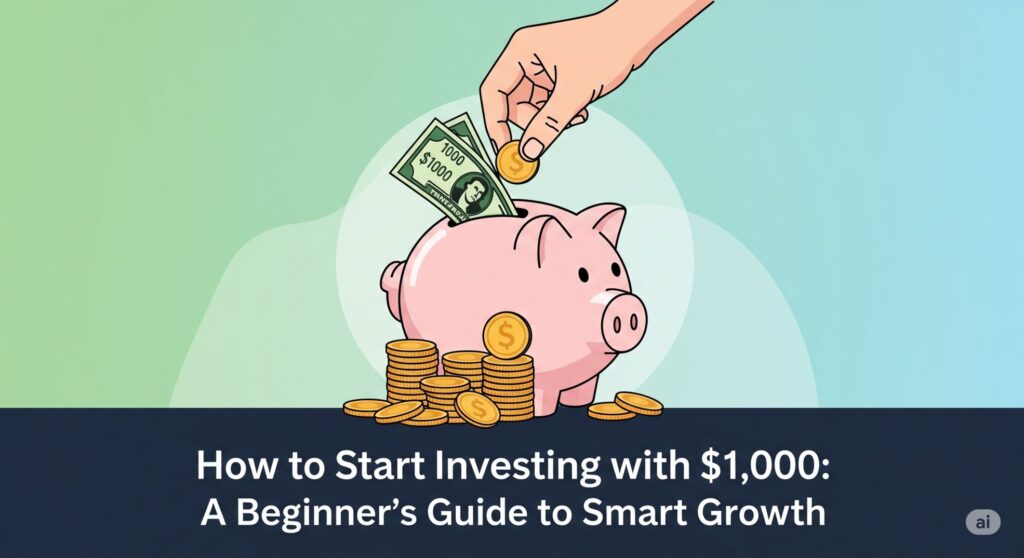
Investing may sound like something reserved for the wealthy, but the truth is—you can start building wealth with as little as $1,000. Whether you’re aiming for financial independence, retirement, or simply want your money to work harder, this guide breaks down how to start investing with $1,000 in a smart, low-risk way.
💡 Why Invest Instead of Save?
While saving money in a bank is safe, it barely keeps up with inflation. Investing, on the other hand, gives your money the potential to grow over time through compounding returns.
| Saving | Investing |
|---|---|
| Low risk | Higher potential returns |
| 0.5–4% interest (typical) | 7–10% annual average (stock market) |
| Good for short-term goals | Ideal for long-term wealth building |
📈 Where to Invest $1,000
Here are the best beginner-friendly options to invest your first $1,000 in 2025:
1. Robo-Advisors (Passive Investing)
- Best for: Hands-off investors
- What it is: Automated platforms like Betterment or Wealthfront build a diversified portfolio based on your goals and risk tolerance.
- Why it’s great: Low fees, automatic rebalancing, and no need to pick individual stocks.
Tip: Start with a risk level you’re comfortable with—most robo-advisors let you choose.
2. Index Funds or ETFs (Exchange-Traded Funds)
- Best for: Long-term, low-cost growth
- Platforms: Fidelity, Vanguard, Schwab
- Why it’s great: Index funds like the S&P 500 ETF (VOO or SPY) let you invest in 500 of the largest U.S. companies at once.
Minimum Investment: Many ETFs have no minimum and can be bought through brokerage apps like Robinhood or Charles Schwab.
3. High-Yield Dividend Stocks
- Best for: Passive income seekers
- What it is: Companies that pay out regular dividends—perfect for generating cash flow.
- Examples: Coca-Cola, AT&T, Johnson & Johnson
Caution: Don’t chase high dividend yields blindly—look at company fundamentals too.
4. Fractional Shares of Big Stocks
- Best for: Buying into high-value companies
- Apps: Robinhood, Fidelity, SoFi
- Why it’s great: Own part of expensive stocks like Amazon or Tesla with as little as $5.
5. Start an IRA (Individual Retirement Account)
- Best for: Retirement savings with tax advantages
- Types: Traditional IRA or Roth IRA
- Why it’s great: Your investments grow tax-free or tax-deferred, depending on the type.
Limit: You can contribute up to $7,000/year in 2025 (if under age 50).
🧠 Smart Tips for First-Time Investors
- ✅ Avoid Timing the Market: Focus on time in the market, not timing it.
- ✅ Diversify: Don’t put all $1,000 in one stock or asset.
- ✅ Automate: Set up automatic monthly contributions—even $50/month adds up.
- ✅ Reinvest Dividends: Let your money snowball by reinvesting earnings.
- ❌ Avoid High Fees: Look for ETFs or funds with low expense ratios (under 0.20%).
⚠️ Mistakes to Avoid
- ❌ Investing without a goal
- ❌ Ignoring fees or taxes
- ❌ Falling for hype or “hot stock” trends
- ❌ Not having an emergency fund before investing
Tip: Always keep 3–6 months of expenses in a high-yield savings account before investing.
🚀 Final Thoughts: $1,000 Is Just the Beginning
Investing $1,000 may not make you rich overnight, but it’s the first step to long-term financial freedom. With smart choices, even a small amount can grow significantly over time thanks to compounding returns.
The key is to start now, stay consistent, and think long-term. Your future self will thank you.